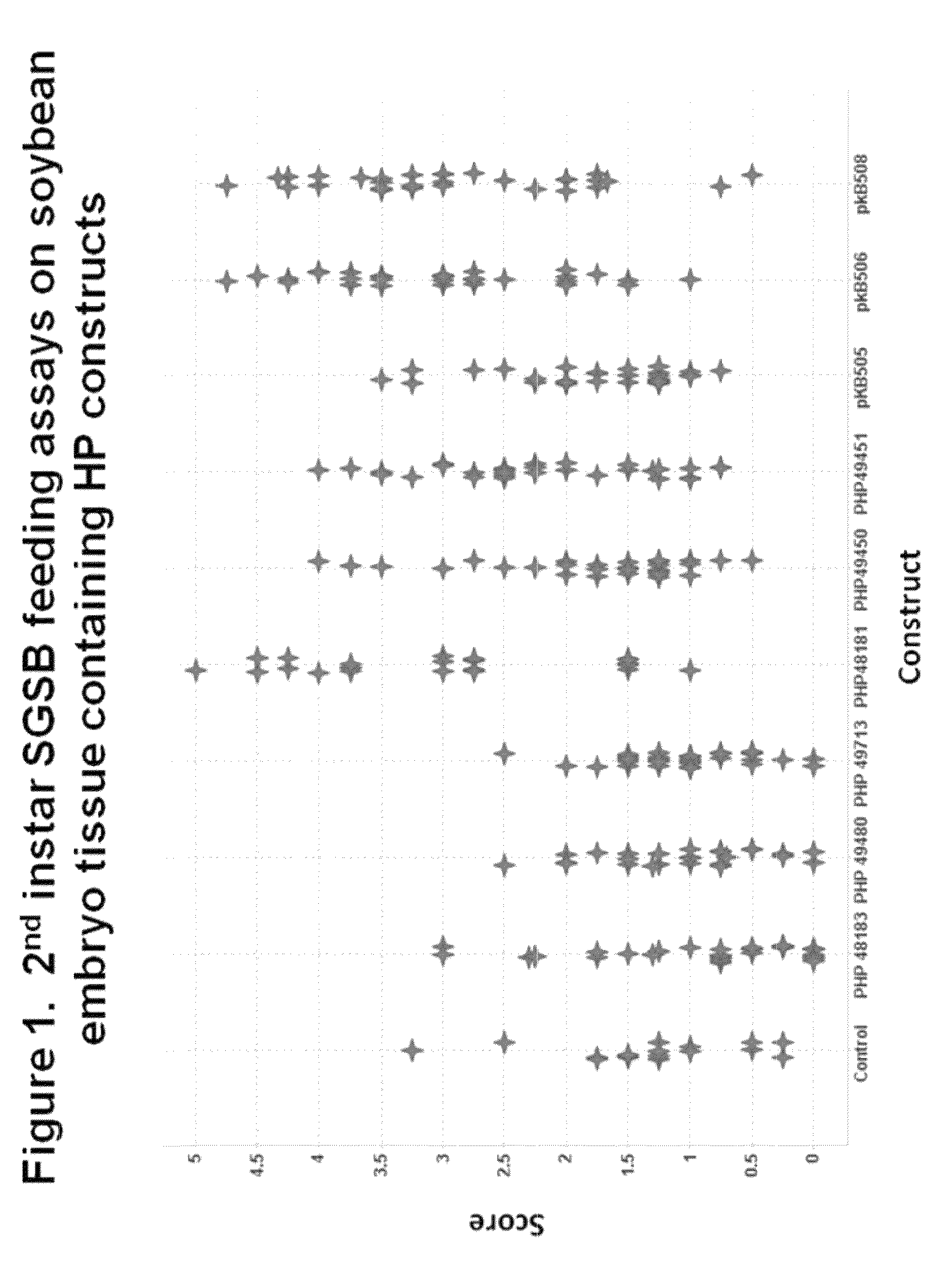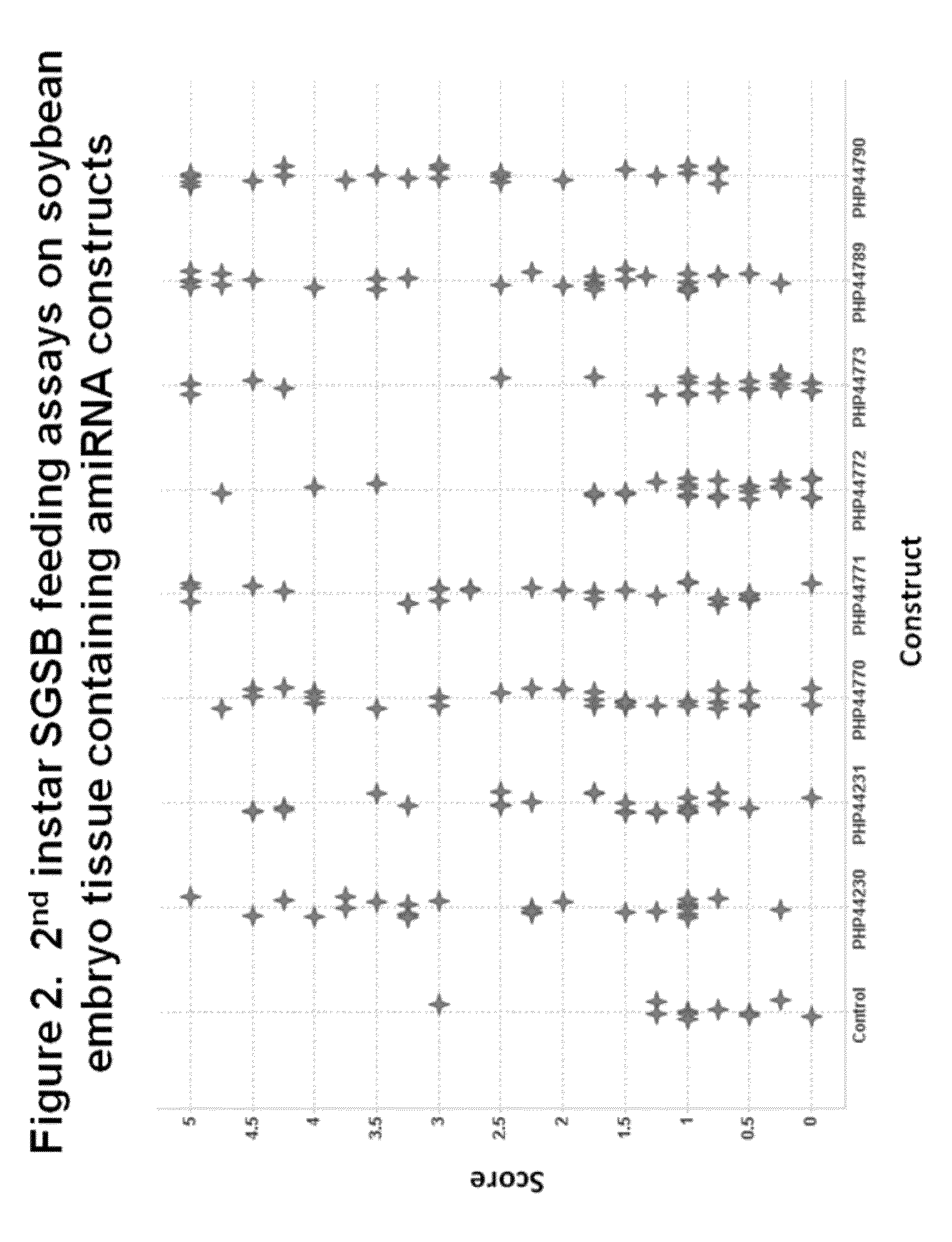Compositions and methods for insecticidal control of stinkbugs
a technology of stinkbugs and compounds, applied in the field of molecular biology and gene silencing to control pests, can solve the problems of destroying millions of acres of staple crops, $100 billion dollars in crop damage, and serious problems of insect pests, and achieves the effect of reducing the level of a target sequence, controlling the pest, and reducing the level of the target sequen
- Summary
- Abstract
- Description
- Claims
- Application Information
AI Technical Summary
Benefits of technology
Problems solved by technology
Method used
Image
Examples
example 1
In Vitro Transcription dsRNA Screening Method
[0138]A high throughput survey of candidate genes from the stinkbug Nezara viridula was performed for their potential utility as a target for RNAi leading to mortality (insecticidal activity of RNAi). A library of over 1000 expressed sequence tags was subjected to in vitro transcription and individual samples tested against 2nd instar nymphs of N. viridula. The insects were fed the sample in an insect assay format. After 6 days, the number of dead nymphs was recorded. Table 1 provides the blast homology (Gene ID) of the various silencing elements (clone name) disclosed herein and also provides bioassay data demonstrating the insecticidal activity of the various sequences when fed to N. viridula.
[0139]
TABLE 16 dayscoreclone nameGene ID#dead / 10inv1c.pk008.f8.fno hits10inv1c.pk003.n13.fconserved hypothetical protein10inv1c.pk003.o24.fconserved hypothetical protein7inv1c.pk004.a3.fcathepsin L1 precursor9inv1c.pk004.a23.fno hits9inv1c.pk004.b4...
example 2
Sequences Having Insecticidal Activity
[0142]DNA sequences which encode double stranded RNAs which were shown to have insecticidal activity against N. viridula using the assay described in Example 1 are set forth in SEQ ID NOS: 1-139.
example 3
Transformation of Maize
[0143]Immature maize embryos from greenhouse donor plants are bombarded with a plasmid containing the silencing element of the invention operably linked to either a tissue specific, tissue selective, or constitutive promoter and the selectable marker gene PAT (Wohlleben et al. (1988) Gene 70:25-37), which confers resistance to the herbicide Bialaphos. In one embodiment, the promoter employed is a seed-preferred promoter. In one embodiment, the constructs will express a long double stranded RNA or a miRNA of the target sequence set forth in SEQ ID NOS: 1-292 or 302-304 or a fragment thereof. In specific embodiments, the target sequence comprises the sequences set forth in SEQ ID NOS: 278, 279, 280, 281, 282, 283, 302, 303 or 304. Such a construct can be linked to a promoter active in maize. Alternatively, the selectable marker gene is provided on a separate plasmid. Transformation is performed as follows. Media recipes follow below.
Preparation of Target Tissue
[...
PUM
| Property | Measurement | Unit |
|---|---|---|
| average diameter | aaaaa | aaaaa |
| time | aaaaa | aaaaa |
| time | aaaaa | aaaaa |
Abstract
Description
Claims
Application Information
 Login to View More
Login to View More - R&D
- Intellectual Property
- Life Sciences
- Materials
- Tech Scout
- Unparalleled Data Quality
- Higher Quality Content
- 60% Fewer Hallucinations
Browse by: Latest US Patents, China's latest patents, Technical Efficacy Thesaurus, Application Domain, Technology Topic, Popular Technical Reports.
© 2025 PatSnap. All rights reserved.Legal|Privacy policy|Modern Slavery Act Transparency Statement|Sitemap|About US| Contact US: help@patsnap.com


